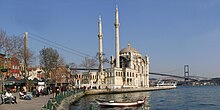Tourism in Turkey is focused largely on a variety of historical sites, and on seaside resorts along its Aegean and Mediterranean Sea coasts. Turkey has also become a popular destination for culture, spa, and health care tourism. At its height in 2014, Turkey attracted around 42 million foreign tourists, ranking as the 6th most popular tourist destination in the world.
This number however declined to around 36 million in 2015 and deteriorated further in 2016,due to regional uncertanities, political tension with Russia, and terrorist attacks.
Istanbul

Ortaköy Mosque and the Bosphorus Bridge
Istanbul is one of the most important tourism spots not only in Turkey
but also in the world. There are thousands of hotels and other
tourist-oriented industries in the city, catering to both vacationers
and visiting professionals. Turkey's largest city, Istanbul, has a
number of major attractions derived from its historical status as
capital of the Byzantine and Ottoman Empires. These include the Sultan Ahmed Mosque (the "Blue Mosque"), the Hagia Sophia, the Topkapı Palace, the Basilica Cistern, the Dolmabahçe Palace, the Galata Tower, the Grand Bazaar, the Spice Bazaar, and the Pera Palace Hotel.
Istanbul has also recently become one of the biggest shopping centers
of the European region by hosting malls and shopping centers, such as Metrocity, Akmerkez and Cevahir Mall,
which is the biggest mall in Europe and seventh largest shopping center
in the world. Other attractions include sporting events, museums, and
cultural events.
In January 2013, the Turkish government announced that it will build the world's largest airport in Istanbul. The operation has an invested 7 billion euros and will have its first part of a four-part plan completed by 2017
As a consequence of the continuous fall in tourism to Turkey in
recent years, as of October 2016 in Istanbul's famous bazaar once
crowded shopping streets are almost empty, "the streams of tourists who
used to visit the market each day have trickled to a halt." The number of foreign tourists visiting Istanbul declined to 9.2 million in 2016, a 26 percent decrease compared to 2015
Other destinations in Turkey

Alanya on the Turkish Riviera

Marmaris
Beach vacations and Blue Cruises, particularly for Turkish delights and visitors from Western Europe, are also central to the Turkish tourism industry. Most beach resorts are located along the southwestern and southern coast, called the Turkish Riviera, especially along the Mediterranean coast near Antalya. Antalya is also accepted as the tourism capital of Turkey. Major resort towns include Bodrum, Fethiye, Marmaris, Kuşadası, Çeşme, Didim and Alanya.
Also Turkey has been chosen second in the world in 2015 with its 436
blue-flagged beaches, according to the Chamber of Shipping.
Lots of cultural attractions elsewhere in the country include the sites of Ephesus, Troy, Pergamon, House of the Virgin Mary, Pamukkale, Hierapolis, Trabzon (where one of the oldest monasteries is the Sümela Monastery), Konya (where the poet Rumi had spent most of his life), Didyma, Church of Antioch, ancient pontic capital and king rock tombs with its acropolis in Amasya, religious places in Mardin (such as Deyrülzafarân Monastery), and the ruined cities and landscapes of Cappadocia.
Diyarbakır is also an important historic city, although tourism is on a relatively small level due to waning armed conflicts.
Ankara has an historic old town, and although it is not exactly a tourist city, is usually a stop for travelers who go to Cappadocia. The city enjoys an excellent cultural life too, and has several museums. The Anıtkabir is also in Ankara. It is the mausoleum of Atatürk, the founder of the Republic of Turkey.
Gallipoli and Anzac Cove - a small cove on the Gallipoli peninsula, which became known as the site of World War I landing of the ANZAC (Australian and New Zealand Army Corps) on 25 April 1915. Following the landing at Anzac Cove, the beach became the main base for the Australian and New Zealand troops for the eight months of the Gallipoli campaign.

Ölüdeniz Beach
Development of tourism
Foreign
tourist arrivals increased substantially in Turkey between 2000 and
2005, from 8 million to 21.2 million, which made Turkey a top-10
destination in the world for foreign visitors. 2005 revenues were US$17.5
billion which also made Turkey one of the top-10 biggest revenue owners
in the world. In 2011, Turkey ranked as the 6th most popular tourist
destination in the world and 4th in Europe, according to UNWTO World Tourism barometer.See World Tourism rankings. At its height in 2014, Turkey attracted around 42 million foreign tourists, still ranking as the 6th most popular tourist destination in the world In 2016, only around 25 million people visited Turkey.
| Year | Arrivals |
|---|---|
| 1995 | 7,083,000 |
| 2000 | 8,000,000 |
| 2005 | 21,200,000 |
| 2010 | 28,632,204 |
| 2011 | 31,456,076 |
| 2012 | 31,785,780 |
| 2013 | 39,724,912 |
| 2014 | 41,263,670 |
| 2015 | 36,244,632 |
| 2016 | 25,352,213 |

Aucun commentaire:
Enregistrer un commentaire